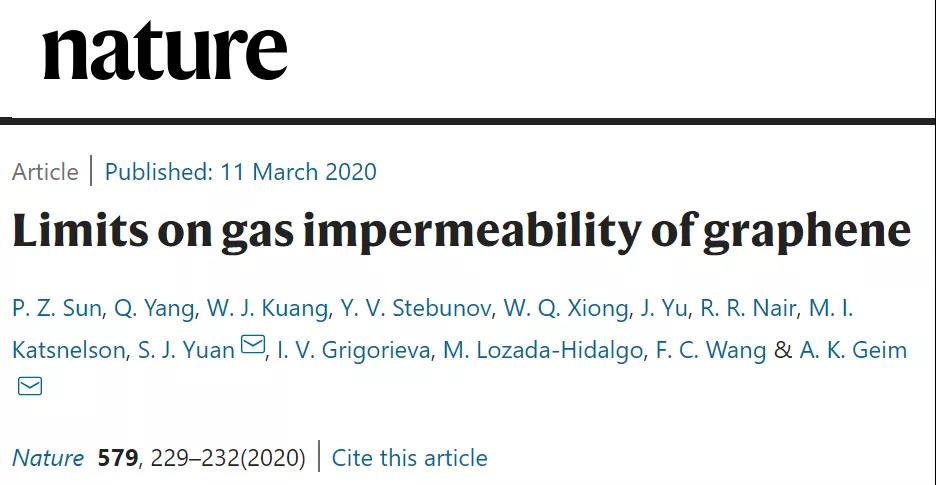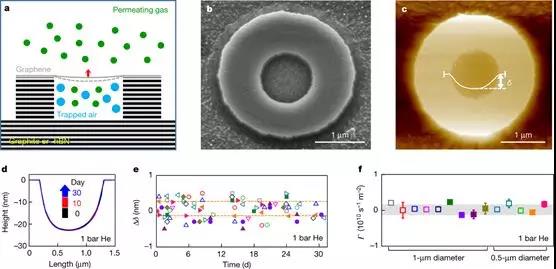
hotline:
17715390137
Tel/Wechat:
18101240246 (Technology)
0512-68565571
Email:mxenes@163.com (Sales Engineer)bkxc.bonnie@gmail.com
Scan the code to follow or search the official account on WeChat:
2D Materials Fronrier After paying attention,
click on the lower right corner to contact us,
Enter enterprise WeChat.
Professional Services Online


Research highlights:
1. The experiment extended the limit of gas impermeability of defect-free graphene.
2. Reveal the mechanism of abnormal permeability of hydrogen in graphene.
The ancients often have thousands of horses, but Bole does not often. As the so-called natural talents are useful, you will not use them, which does not mean that they are useless.
Graphene‘s Nobel Prize has recently been deprecated. Some people have mixed it with bird feces, and some people have won international awards. It can be described as embarrassing and stressful. In any case, you still have to stick to your heart. On the one hand, do more research and don‘t rot the good materials. On the other hand, don‘t listen to what is good, say halfway, and doubt yourself.
Today, the father of graphene, the Nobel laureate of the University of Manchester in the UK, A. K. Geim‘s team posted in Nature and made another breakthrough in the field of graphene basic research. The following is a brief introduction, hoping to inspire researchers in related fields.
Non-defective two-dimensional materials represented by single-layer graphene, although only one atomic layer thick, are considered to have no gas and liquid permeability.
In theory:
DFT calculations show that single-layer graphene has very high energy barriers for atom and molecule permeability, at least a few electron volts. Therefore, under normal conditions, no gas can pass through the defect-free single-layer graphene. At room temperature, it takes longer for an atom to penetrate a defect-free film than the history of the universe.
Experimentally:
Taking mechanically stripped graphene as an example, micron-sized holes etched on a silicon oxide wafer and sealed with graphene to study the gas permeability. The results showed that no gas transmission was found, and the detection sensitivity reached 105-106 atoms / second.
So, is graphene gas really impermeable? What is the limit? What is the mechanism?
In view of this, the AK Geim team of the University of Manchester Nobel Laureate, who is known as the father of graphene, has further confirmed the impermeability of defect-free graphene through experiments, expanding the impermeability limit, and revealing that Abnormal permeability mechanism in alkenes.

Figure 1. Impermeability experimental setup
The researchers used a non-defective single-layer graphene sealed small single crystal container as an experimental device. The research showed that the non-defective graphene is indeed impermeable to gas, and its detection accuracy is improved by 8-9 compared with previous experiments. Magnitude.
The study points out that although there is no direct evidence, the authors can discern that only a few helium atoms per hour can pass through under such an extremely high detection limit. This behavior is consistent for almost all other gases (neon, nitrogen, oxygen, argon, and xenon), with the exception of hydrogen.
Even though hydrogen molecules are larger than helium and should experience higher energy barriers, hydrogen exhibits more pronounced permeability. This anomalous result is mainly attributed to the following mechanism: 1) dissociation of the catalytically active graphene ripple at the hydrogen molecule; 2) the adsorbed hydrogen atom flips to the other side of the graphene sheet with a lower activation energy. Research indicates that this activation energy is about 1.0 eV, which is close to the energy required for proton transfer.
Figure 2. Hydrogen permeability experiment
In short, this research provides a fundamental consideration for the impermeability of two-dimensional materials from a basic perspective, and also points out a new direction for the study of graphene.
In addition, this study sets a new paradigm for our basic research. Really pure basic research should focus more on the basic properties, rather than rendering too many possible application prospects, unless you can really do it. Such basic research will often open up a whole new field.
references:
P. Z. Sun et al. Limitson gas impermeability of graphene. Nature 2020.
https://www.nature.com/articles/s41586-020-2070-x
Source: Nanoman


| Reminder: Beijing Beike New Material Technology Co., Ltd. supplies products only for scientific research, not for humans |
| All rights reserved © 2019 beijing beike new material Technology Co., Ltd 京ICP备16054715-2号 |